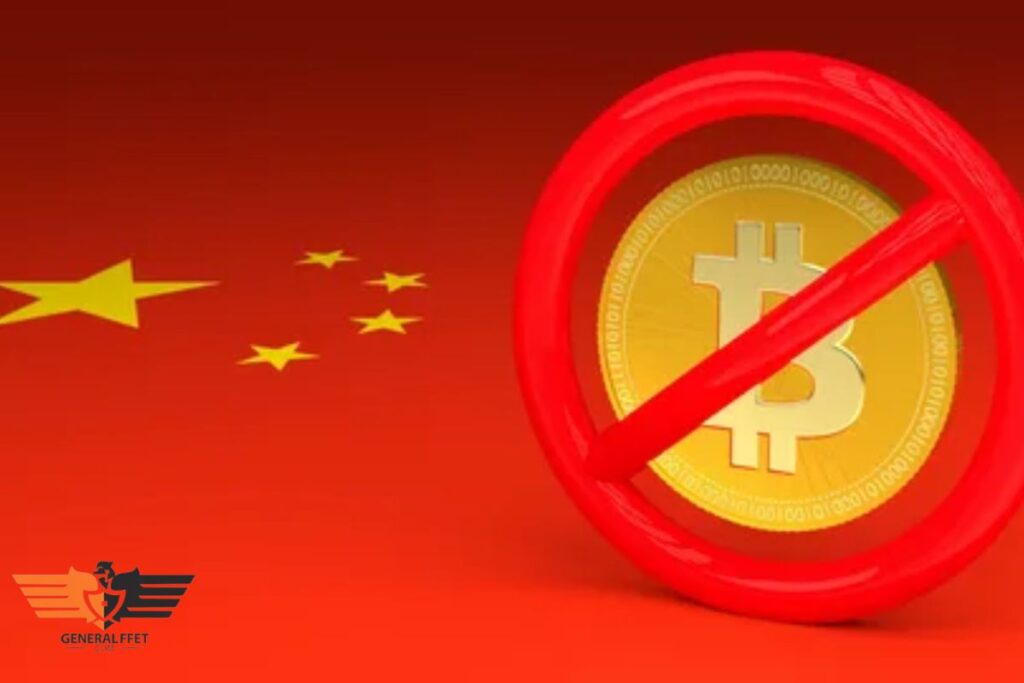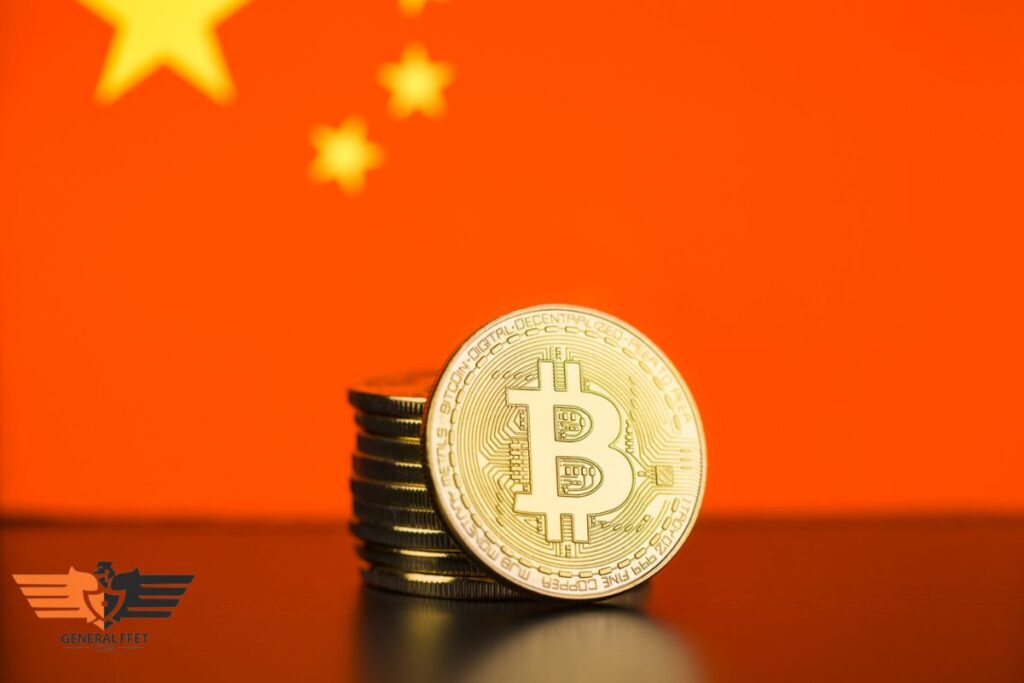In a move that sent shockwaves through the global financial world, China has implemented a sweeping ban on cryptocurrencies.
This digital asset prohibition has far-reaching implications, not just for Chinese investors but for the entire crypto ecosystem.
As detailed on, the ban marks a pivotal moment in the ongoing saga of crypto regulation. Let’s move into the depths of this virtual currency restriction and explore its multifaceted impact on the world of finance.
Historical Context of China’s Cryptocurrency Ban

China’s relationship with cryptocurrencies has been a rollercoaster ride. Initially, the country embraced virtual assets with open arms, becoming a hub for Bitcoin mining and trading.
This early adoption was fueled by the country’s tech-savvy population and abundant cheap electricity, making it a prime location for cryptocurrency extraction. However, as the crypto market grew more volatile and concerns about financial stability mounted, Chinese authorities began to view digital cash with increasing skepticism.
The government’s worries about capital flight, money laundering, and the potential threat to its monetary control set the stage for a series of regulatory actions that would culminate in the current ban.
The Rise and Fall of Crypto in the Middle Kingdom
China’s journey from crypto paradise to prohibition is a cautionary tale of innovation clashing with regulation.
As crypto tokens gained popularity, they challenged the government’s ability to maintain economic security and monetary control. This tension between decentralized finance and state authority would shape China’s approach to blockchain technology for years to come.
Previous Regulatory Measures
Before the all-out ban, China had taken several steps to curb crypto enthusiasm. In 2013, the government prohibited banks from handling Bitcoin transactions. This was followed by a crackdown on initial coin offerings (ICOs) in 2017, which dealt a significant blow to the cybercurrency market.
These earlier policy actions were aimed at reducing financial risks and maintaining fiscal balance. However, they also drove much of China’s crypto activity underground, creating a cat-and-mouse game between regulators and crypto enthusiasts.
Beijing’s Crypto Crackdown Timeline
| Year | Action |
| 2013 | Banks banned from Bitcoin transactions |
| 2017 | ICOs prohibited |
| 2019 | Plans announced to block access to domestic and foreign crypto exchanges |
| 2021 | Full ban on crypto transactions and mining |
Current Implications of the Ban
The current ban, implemented in 2021, represents the most comprehensive set of legal restrictions on cryptocurrencies to date. It prohibits all crypto transactions and mining activities within China’s borders, effectively shutting down what was once the world’s largest Bitcoin mining network.
This move has had immediate and far-reaching consequences. Chinese investors have been forced to liquidate their holdings or find ways to circumvent the ban. Meanwhile, the global crypto market has had to reckon with the loss of one of its largest and most influential players, leading to significant volatility and uncertainty.
Shockwaves Through the Crypto Sphere
The ripple effects of China’s ban have been felt across the entire blockchain ecosystem. Mining operations have scrambled to relocate, causing a temporary drop in the global hash rate. Crypto exchanges have had to adapt their policies, and investors worldwide have had to reassess their strategies in light of this new regulatory landscape.
Impact on Cryptocurrency Values

When news of China’s ban broke, it sent cryptocurrency values into a tailspin. Bitcoin, Ethereum, and other major crypto tokens saw significant price drops as investors grappled with the implications of losing access to the Chinese market.
This volatility underscored the interconnectedness of global crypto markets and the outsized influence of regulatory decisions. However, the market has shown resilience. After the initial shock, prices began to stabilize as the crypto community adapted to the new reality.
Some even view China’s exit from the market as a positive development for the long-term decentralization of cryptocurrencies.
When the Dragon Roars, Bitcoin Trembles
The phrase “When China sneezes, Bitcoin catches a cold” has never been more apt. The ban’s impact on crypto prices serves as a stark reminder of the market’s sensitivity to regulatory actions.
It also highlights the need for a more diverse and resilient global crypto ecosystem that can withstand regional shocks.
Investor Reactions to the Ban
Chinese investors have been forced to make tough decisions in the wake of the ban. Many have turned to virtual private networks (VPNs) and overseas exchanges to maintain their crypto holdings, while others have liquidated their assets entirely.
This has led to a significant outflow of capital from the Chinese crypto market. International investors, meanwhile, have had to reassess their exposure to Chinese-related crypto assets.
Some see the ban as an opportunity, betting on increased decentralization and the emergence of new mining hubs in other parts of the world. Others remain cautious, wary of the potential for similar regulatory actions in other countries.
From Panic to Opportunity: How Traders Responded
The initial panic selling has given way to more strategic thinking among savvy investors. Many are now focusing on portfolio management and risk mitigation strategies that can weather regulatory storms. This includes diversifying into more regulation-resistant assets and exploring opportunities in emerging crypto-friendly jurisdictions.
Market Sentiment and Volatility
The crypto market’s response to China’s ban has been characterized by extreme volatility. Fear, uncertainty, and doubt (FUD) have led to wild price swings as traders try to anticipate the next regulatory move. This volatility has been particularly challenging for newcomers to the crypto space, highlighting the importance of risk mitigation strategies.
Despite the turbulence, many in the crypto community remain optimistic about the long-term prospects of digital assets. They argue that the ban will ultimately lead to a more robust and decentralized crypto ecosystem, less dependent on any single country or regulatory regime.
Riding the Crypto Rollercoaster
For those invested in the crypto market, the past year has been a wild ride. Price charts resemble a rollercoaster, with steep drops followed by rapid ascents.
This volatility has tested the resolve of even the most committed crypto enthusiasts, but it has also created opportunities for those able to navigate the turbulent waters.
Government Reactions to China’s Cryptocurrency Ban

China’s decisive action has prompted other governments to reassess their own approaches to crypto regulation. Some countries have viewed China’s ban as a model to follow, citing similar concerns about financial stability and monetary control.
Others have taken a more nuanced approach, seeking to balance innovation with regulatory oversight. In the United States, for example, regulators have stepped up their scrutiny of crypto exchanges and stablecoins, but have stopped short of an outright ban.
The European Union is working on a comprehensive regulatory framework for digital assets, aiming to provide clarity while fostering innovation.
A Domino Effect or a Lone Wolf Move?
While China’s ban represents the most extreme form of crypto regulation, it has not triggered a global domino effect as some had feared.
Instead, it has sparked a nuanced debate about the role of digital currencies in the modern financial system. Many governments are now exploring ways to harness the benefits of blockchain technology while mitigating its risks.
Financial Institutions’ Adjustments
Banks and other financial companies have had to rapidly adapt to the new reality of a crypto-free China. Many institutions that had been exploring blockchain-based services have had to shelve their plans or pivot to other technologies. This has led to a reshuffling of priorities and resources within the financial sector.
Internationally, financial institutions are reassessing their relationships with crypto-related businesses. Some have doubled down on their crypto offerings, seeing an opportunity to capture market share in the wake of China’s exit. Others have become more cautious, wary of potential regulatory risks in their own jurisdictions.
Banks and Crypto: A New Chapter
The relationship between traditional financial organizations and the crypto world is evolving rapidly.
As banks grapple with the implications of China’s ban, many are exploring ways to offer crypto-adjacent services that comply with local regulations. This has led to the development of new products and services that bridge the gap between traditional finance and the world of digital assets.
Reactions from Crypto Communities
The global crypto community has responded to China’s ban with a mix of defiance and innovation. Many see it as a challenge to be overcome, spurring efforts to create more resilient and decentralized systems.
This has led to increased interest in technologies like decentralized exchanges (DEXs) and privacy coins that are more resistant to regulatory interference.
At the same time, the ban has highlighted the need for greater engagement between the crypto community and regulators. Many industry leaders are now advocating for more proactive dialogue to shape sensible regulations that protect consumers without stifling innovation.
The Crypto World Fights Back
“The cryptocurrency community is nothing if not resilient. China’s ban is just another hurdle to overcome on the path to a more decentralized financial future.” – Anonymous Crypto Analyst
This sentiment echoes throughout the crypto world, where adversity is often seen as an opportunity for growth and innovation. The community’s response to China’s ban may well shape the future of decentralized finance for years to come.
New Regulatory Framework Implemented

China’s new regulatory framework for cryptocurrencies is comprehensive and far-reaching. It not only prohibits crypto transactions and mining but also targets related activities such as advertising and promotion of digital assets. The framework is designed to give authorities broad powers to crack down on any crypto-related activities.
This new legal structure has forced businesses and individuals to quickly adapt or face severe penalties. It has also created challenges for enforcement, as the decentralized nature of cryptocurrencies makes them inherently difficult to control. The government has had to develop new tools and strategies to monitor and prevent crypto activities within its borders.
Inside China’s Crypto Clampdown
The nuts and bolts of China’s crypto ban involve a multi-pronged approach. This includes blocking access to crypto exchanges, shutting down mining operations, and implementing strict compliance requirements for financial institutions.
The government has also launched public education campaigns to warn citizens about the risks of cryptocurrency investments.
Enforcement Strategies and Surveillance
To enforce its crypto ban, China has deployed a range of high-tech surveillance tools. These include monitoring internet traffic for crypto-related activities, analyzing financial transactions for signs of crypto use, and even using satellite imagery to detect large-scale mining operations.
The government has also enlisted the help of tech giants and financial institutions to identify and report suspicious activities. This comprehensive approach to enforcement has made it increasingly difficult for Chinese citizens to engage in crypto activities without detection.
Big Brother is Watching Your Wallet
The level of surveillance employed to enforce the crypto ban has raised concerns about privacy and civil liberties.
Critics argue that the measures used to detect crypto activities could easily be repurposed for other forms of financial surveillance, potentially giving the government unprecedented insight into citizens’ financial lives.
Impact on Cryptocurrency Businesses
The ban has had a devastating impact on China’s once-thriving crypto industry. Mining companies have been forced to relocate or shut down entirely, while exchanges and other crypto-related businesses have had to cease operations or move offshore.
This exodus has led to a significant brain drain in China’s tech sector and a redistribution of crypto expertise to other parts of the world. For businesses outside of China, the ban has created both challenges and opportunities.
The loss of Chinese customers and partners has been a blow for many international crypto companies. However, some have benefited from reduced competition and the influx of talent and resources from China.
When the Music Stops: Crypto Exodus from China
The story of Bitmain, once the world’s largest manufacturer of Bitcoin mining equipment, illustrates the impact of the ban.
The company was forced to halt sales of its mining rigs in China and has since focused on international markets. This shift has reshaped the global mining landscape and highlighted the adaptability of crypto businesses in the face of regulatory challenges.
Broader Economic and Financial Implications
The implications of China’s crypto ban extend far beyond the digital asset space. By effectively removing itself from the global crypto economy, China has ceded influence in an increasingly important sector of international finance. This could have long-term consequences for China’s ambitions to internationalize its currency and play a larger role in the global financial system.
The ban has also accelerated the development of crypto industries in other countries. Nations like El Salvador, which has adopted Bitcoin as legal tender, are positioning themselves as crypto-friendly alternatives to China. This shift in the crypto landscape could have significant implications for global finance and the balance of economic power.
Read Related Article…Beldames Nyt in Print: A Fascinating Journey Through The New York Times
Beyond Bitcoin: Ripple Effects on Global Finance
The crypto ban is just one part of China’s broader strategy to maintain economic security and monetary control.
By cracking down on decentralized currencies, China is paving the way for its own digital renminbi, or e-CNY. This Chinese CBDC could give the government unprecedented control over monetary policy and financial transactions, potentially reshaping the landscape of international commerce.
Financial Impact on Chinese Investors
For Chinese investors who had embraced cryptocurrencies, the ban has been nothing short of devastating. Many have seen their virtual holdings become effectively worthless overnight, unable to easily liquidate or transfer their assets.
This has led to significant financial losses and a scramble to find alternative investment opportunities. Some investors have turned to grey market solutions, using VPNs and overseas contacts to maintain their crypto activities.
However, these methods carry significant legal and financial risks. Others have shifted their focus to more traditional investments, leading to increased activity in China’s stock and real estate markets.
From Crypto Millionaires to Digital Refugees
The ban has created a new class of “digital refugees” – Chinese crypto enthusiasts forced to operate in the shadows or leave the country to pursue their interests.
This brain drain could have long-term implications for China’s tech sector and its ability to compete in the rapidly evolving world of blockchain technology.
Alternative Investment Strategies
With cryptocurrencies off the table, Chinese investors have had to rethink their portfolio management strategies. Many have turned to traditional safe havens like gold and government bonds.
Others are exploring alternative investments such as art, collectibles, and foreign real estate. The ban has also sparked increased interest in China’s domestic stock market and the country’s burgeoning tech sector.
Some investors see these areas as potential alternatives to the high-growth, high-risk profile that attracted them to cryptocurrencies in the first place.
Life After Crypto: Where’s the Money Flowing?
Here’s a breakdown of where Chinese investors are redirecting their funds:
| Investment Type | Percentage of Former Crypto Investors |
| Domestic Stocks | 35% |
| Real Estate | 25% |
| Foreign Stocks | 20% |
| Gold and Commodities | 15% |
| Other Alternatives | 5% |
Legal Consequences of Cryptocurrency Trading
The legal risks for those who continue to engage in crypto activities in China are severe. Penalties can include fines, asset seizures, and even imprisonment for serious offenses. The government has made it clear that it views crypto trading as a threat to economic stability and will not hesitate to crack down on violators.
This harsh stance has created a climate of fear among former crypto enthusiasts. Many are wary of discussing their past involvement in the space, let alone continuing their activities. The legal consequences have effectively driven the crypto community underground, making it difficult to assess the true extent of ongoing crypto activities in China.
Walking the Tightrope: Risks of Defying the Ban
For those willing to risk defying the ban, the consequences can be severe. In one high-profile case, a Chinese citizen was sentenced to three years in prison for operating a small-scale Bitcoin mining operation. This case serves as a stark warning to others who might be tempted to skirt the regulations.
Broader Implications for the Investment Landscape

China’s crypto ban has reshaped the global investment landscape, particularly in the realm of digital assets. The exodus of Chinese capital and expertise from the crypto market has created opportunities for investors and entrepreneurs in other parts of the world.
Countries with crypto-friendly regulations are seeing an influx of talent and investment, potentially setting the stage for new innovation hubs. The ban has also highlighted the importance of regulatory clarity in the crypto space.
Investors and businesses are increasingly looking for jurisdictions that offer a balanced approach to regulation, providing consumer protections without stifling innovation. This could lead to a more mature and stable crypto market in the long run.
Reshaping the Global Investment Chessboard
The shift in the crypto landscape is part of a broader realignment in global finance. As digital assets become an increasingly important part of the financial ecosystem, countries’ stances on crypto regulation could become a significant factor in their overall economic competitiveness.
China’s Digital Yuan Initiative
While cracking down on decentralized cryptocurrencies, China has been pushing forward with its own digital renminbi, or e-CNY. This Chinese CBDC is designed to give the government greater control over the money supply and financial transactions while providing many of the benefits of digital currencies.
The digital yuan represents a bold experiment in monetary control. If successful, it could provide a model for other countries looking to balance the benefits of digital currencies with the need for regulatory oversight. However, it also raises concerns about privacy and the potential for increased financial surveillance.
Read Related Article…Kristy Greenberg Wikipedia: The Legal Maverick Reshaping America’s Justice System
Enter the Dragon: China’s Own Crypto Revolution
The e-CNY is more than just a digital version of China’s currency. It’s a powerful tool for implementing monetary policy and maintaining economic stability.
With the ability to program money and track transactions in real-time, the digital yuan could give Chinese authorities unprecedented control over the country’s financial system.
Strategic Government Objectives
China’s approach to cryptocurrencies and its development of the digital yuan are part of a broader strategy to maintain economic security and assert its influence in the global financial system.
By banning decentralized cryptocurrencies while developing its own digital currency, China aims to harness the benefits of blockchain technology while maintaining strict monetary control.
This strategy aligns with China’s broader economic goals, including internationalizing the renminbi and reducing dependence on the US dollar in international trade. The e-CNY could potentially challenge the dollar’s dominance in global finance, particularly in regions where China has significant economic influence.
Beijing’s Master Plan: Beyond the Ban
China’s crypto strategy is multifaceted, involving not just prohibition of private cryptocurrencies but also investment in blockchain technology and the rollout of the digital yuan. This approach reflects a desire to be at the forefront of financial innovation while maintaining the state’s central role in the economy.
Implications for the Cryptocurrency Market

The absence of Chinese investors and miners from the global crypto market has led to significant shifts in the industry. Mining operations have relocated to countries with abundant cheap energy, like Kazakhstan and Texas, reshaping the geographic distribution of the Bitcoin network.
Trading volumes on major exchanges have also been affected, with a noticeable drop in Asian trading hours. However, the market has shown remarkable resilience, with new players stepping in to fill the void left by Chinese participants. This redistribution of crypto activity could lead to a more decentralized and robust ecosystem in the long run.
David vs Goliath: Crypto’s Fight Against Central Banks
The clash between decentralized cryptocurrencies and state-backed digital currencies like the e-CNY represents a pivotal moment in the evolution of money. It’s a battle between two competing visions: one of decentralized, borderless finance, and another of enhanced state control over monetary systems.
Broader Financial Impact
China’s crypto ban and digital yuan initiative have implications that extend far beyond its borders. Other countries are closely watching China’s experiment with CBDC, with many central banks accelerating their own digital currency projects in response.
The ban has also highlighted the need for a more coordinated global approach to crypto regulation.
As different countries adopt varying stances on digital assets, there’s a risk of regulatory arbitrage and fragmentation in the global financial system. This could potentially undermine efforts to combat money laundering and other financial crimes.
The Butterfly Effect: How China’s Ban Reshapes Global Finance
“China’s crypto ban is like a stone thrown into a pond. The immediate splash is dramatic, but it’s the ripples that will reshape the shoreline of global finance.” – Financial Analyst at a major investment bank
Energy Consumption Concerns
One of the driving factors behind China’s crypto ban was concern over the energy consumption associated with Bitcoin mining.
At its peak, crypto mining in China was consuming more electricity than some small countries, raising sustainability concerns and conflicting with the country’s climate goals. The ban has led to a significant reduction in China’s carbon emissions from crypto mining.
However, it has also resulted in a global redistribution of mining activities, with some operations moving to countries with less environmentally friendly energy sources.
Green vs. Greed: The Environmental Cost of Crypto
The ecological footprint of cryptocurrencies remains a contentious issue. While some argue that crypto mining can incentivize the development of renewable energy sources, others see it as an unnecessary drain on resources in a world grappling with climate effects.
China’s Environmental Policies
China’s crypto ban aligns with its broader environmental initiatives, including its pledge to reach carbon neutrality by 2060. By eliminating crypto mining, China has removed a significant obstacle to achieving its sustainability goals.
The government is now focusing on promoting “green” technologies and industries. This shift could potentially accelerate China’s transition to a more sustainable economy, with implications for global efforts to combat climate change.
Read Related Article…Unveiling Arcangel: Height, Age, Bio, Career & Net Worth of Reggaeton’s Rising Star
Clean Air or Digital Gold: China’s Green Gambit
China’s decision to prioritize environmental concerns over the potential economic benefits of the crypto industry represents a significant shift in policy. It signals a growing recognition of the importance of sustainability in shaping economic decisions.
Global Environmental Perspectives
China’s ban has sparked a global conversation about the environmental impact of cryptocurrencies. Some countries are considering similar measures, while others are exploring ways to make crypto mining more sustainable.
Innovations in this space include the development of more energy-efficient consensus mechanisms, like proof-of-stake, and the use of stranded or excess renewable energy for mining operations. These efforts could help address the ecological footprint of cryptocurrencies while preserving their innovative potential.
A Greener Crypto Future?
The push for more sustainable cryptocurrencies could lead to significant innovations in both blockchain technology and renewable energy. As the industry evolves, we may see the emergence of new, environmentally friendly digital assets that address the concerns raised by China’s ban.
Uncertain Future of Cryptocurrencies in China

Despite the comprehensive nature of China’s crypto ban, the future remains uncertain. The decentralized and borderless nature of cryptocurrencies makes them inherently difficult to control, and there’s always the possibility of policy shifts in the future.
Some speculate that China might eventually soften its stance on cryptocurrencies, particularly if they become an integral part of the global financial system. Others believe that the ban will remain in place, with China focusing exclusively on its digital yuan project.
Crystal Ball Gazing: What’s Next for Crypto in China?
The future of cryptocurrencies in China will likely depend on a variety of factors, including the success of the e-CNY, global regulatory trends, and the evolving role of digital assets in the world economy. While the current outlook is bleak, the only certainty in the crypto world is change.
Frequently Asked Questions
Why did China ban cryptocurrencies?
China banned cryptocurrencies due to concerns about financial stability, energy consumption, and maintaining monetary control. The government views decentralized finance as a potential threat to its economic security and ability to manage the financial system.
How has the ban affected global crypto prices?
The ban initially caused significant volatility in crypto markets, with prices dropping sharply. However, the market has since shown resilience, adapting to the absence of Chinese participants. Long-term effects on prices remain to be seen.
What alternatives do Chinese investors have?
Chinese investors have turned to traditional investments like stocks and real estate. Some are exploring grey market options to maintain crypto exposure, while others are looking at overseas investment opportunities.
Is the ban likely to be permanent?
While the current ban is comprehensive, the future is uncertain. Policy changes could occur, especially if cryptocurrencies become more integrated into the global financial system. However, any changes would likely be gradual and tightly controlled.
How does China’s digital yuan differ from cryptocurrencies?
The digital yuan (e-CNY) is a central bank digital currency (CBDC), meaning it’s issued and controlled by the state. Unlike decentralized cryptocurrencies, it doesn’t offer the same level of anonymity and is designed to enhance rather than challenge government monetary control.
Final Thoughts
China’s cryptocurrency ban represents a seismic shift in the global digital asset landscape. It has reshaped the geography of crypto mining, altered investment flows, and accelerated the development of central bank digital currencies.
The future remains uncertain, but one thing is clear: China’s crypto ban has forever altered the trajectory of digital finance. As blockchain technology continues to evolve and central bank digital currencies like the e-CNY come online, we’re witnessing nothing less than a revolution in the nature of money itself.
Read Related Article…

Admin of GeneralFet.com, dedicated to providing diverse and insightful content on a wide range of general topics. Passionate about sharing knowledge and fostering a community of curious minds.








